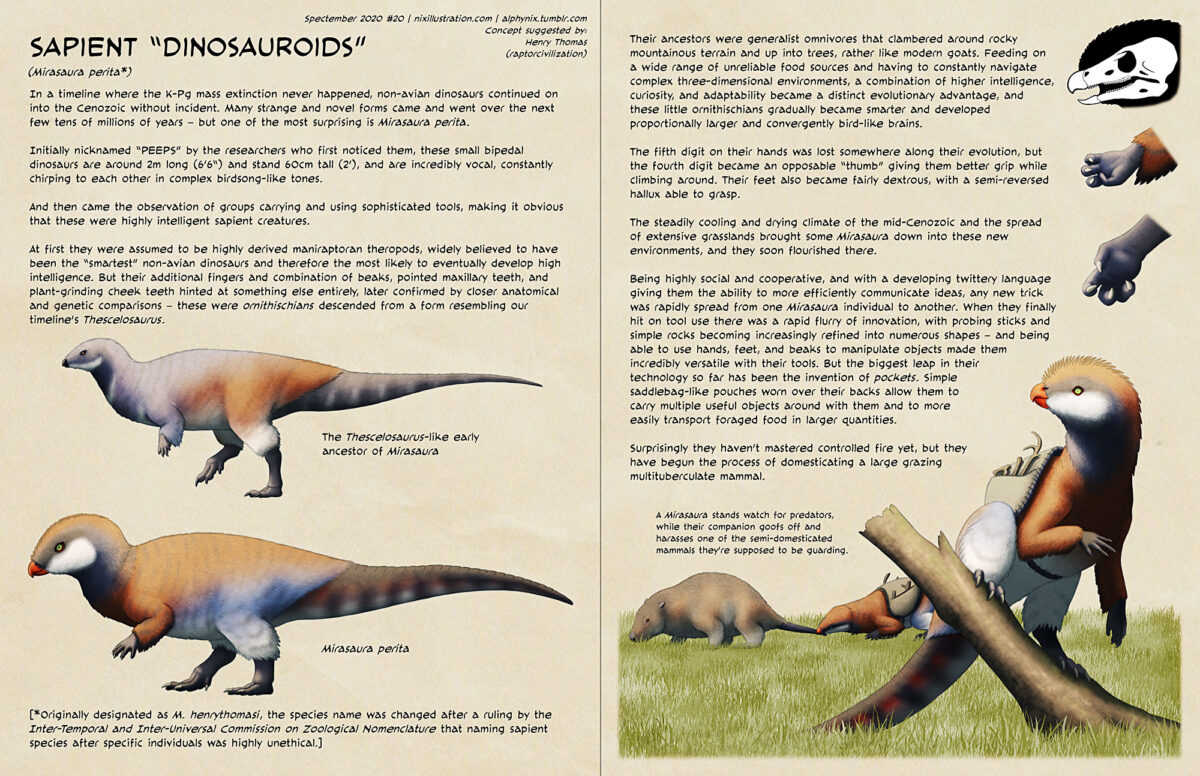Transcript for the text on the image under the cut:
PAGE 1
Spectember 2020 #20 | nixillustration.com | alphynix.tumblr.com
Concept suggested by:
Henry Thomas
(raptorcivilization)
Sapient “Dinosauroids”
(Mirasaura perita*)
In a timeline where the K-Pg mass extinction never happened, non-avian dinosaurs continued on into the Cenozoic without incident. Many strange and novel forms came and went over the next few tens of millions of years – but one of the most surprising is Mirasaura perita.
Initially nicknamed “PEEPS” by the researchers who first noticed them, these small bipedal dinosaurs are around 2m long (6’6“) and stand 60cm tall (2′), and are incredibly vocal, constantly chirping to each other in complex birdsong-like tones.
And then came the observation of groups carrying and using sophisticated tools, making it obvious that these were highly intelligent sapient creatures.
At first they were assumed to be highly derived maniraptoran theropods, widely believed to have been the “smartest” non-avian dinosaurs and therefore the most likely to eventually develop high intelligence. But their additional fingers and combination of beaks, pointed maxillary teeth, and plant-grinding cheek teeth hinted at something else entirely, later confirmed by closer anatomical and genetic comparisons – these were ornithischians descended from a form resembling our timeline’s Thescelosaurus.
[*Originally designated as M. henrythomasi, the species name was changed after a ruling by the Inter-Temporal and Inter-Universal Commission on Zoological Nomenclature that naming sapient species after specific individuals was highly unethical.]
[Image: a bipedal ornithischian dinosaur. It has a small head with a beak at the tip of its jaws, small forearms with five fingers, and bird-like legs. Most of its body is covered in fluffy “protofeathers”, except for its hands, feet, and long scaly tail.]
The Thescelosaurus-like early ancestor of Mirasaura
[Image: a sentient descendant of the Thescelosaurus-like dinosaur. Its head is proportionally larger with a slightly more hooked parrot-like beak, it has three clawed fingers and a clawless “thumb” on its hands (except the thumb is formed from the fourth digit rather than the first), and an overall much stockier body.]
Mirasaura perita
PAGE 2
Their ancestors were generalist omnivores that clambered around rocky mountainous terrain and up into trees, rather like modern goats. Feeding on a wide range of unreliable food sources and having to constantly navigate complex three-dimensional environments, a combination of higher intelligence, curiosity, and adaptability became a distinct evolutionary advantage, and these little ornithischians gradually became smarter and developed proportionally larger and convergently bird-like brains.
The fifth digit on their hands was lost somewhere along their evolution, but the fourth digit became an opposable “thumb” giving them better grip while climbing around. Their feet also became fairly dextrous, with a semi-reversed hallux able to grasp.
The steadily cooling and drying climate of the mid-Cenozoic and the spread of extensive grasslands brought some Mirasaura down into these new environments, and they soon flourished there.
Being highly social and cooperative, and with a developing twittery language giving them the ability to more efficiently communicate ideas, any new trick was rapidly spread from one Mirasaura individual to another. When they finally hit on tool use there was a rapid flurry of innovation, with probing sticks and simple rocks becoming increasingly refined into numerous shapes – and being able to use hands, feet, and beaks to manipulate objects made them incredibly versatile with their tools. But the biggest leap in their technology so far has been the invention of pockets. Simple saddlebag-like pouches worn over their backs allow them to carry multiple useful objects around with them and to more easily transport foraged food in larger quantities.
Surprisingly they haven’t mastered controlled fire yet, but they have begun the process of domesticating a large grazing multituberculate mammal.
[Image: details of Mirasaura‘s anatomy. An x-ray view of their head shows the somewhat vulture-like shape of the skull beneath the feathers, along with the pointed teeth just behind the beak, the grinding teeth further back, and the enlarged braincase. A close-up of the hand shows the “backwards” thumb, and a close-up of the foot shows its bird-like grasping ability.]
[Image: a Mirasaura perching on a dead tree stump in swath of grassland, wearing a saddlebag-like “backpack” stuffed with unidentifiable tools. In the background a second individual is harassing a large herbivorous rodent-like mammal by pulling on its tail.]
A Mirasaura stands watch for predators, while their companion goofs off and harasses one of the semi-domesticated mammals they’re supposed to be guarding.

